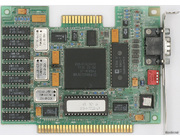Paradise PVGA1A JK
Great little card. Despite it's age and simplicity it works very well in early systems (XT, 286). I used to have this card in my ARC ProTurbo 88 until I switched over to a CGA-card + monitor to obtain true CGA-graphics.
If you're looking for the dip-switch configuration:
There is also a 16-bit ISA version of this card.Switch 1 Monitor Type. ON: Multi frequency, OFF: Standard VGA
Switch 2 VGA Mode Switching Style. ON: PS/2 Style - All modes available on all monitors, OFF: PC/AT Style - color on color, mono on mono
Switch 3 Not used - Set to OFF
Switch 4 (Not VGA Plus) 8bit vs 16bit AutoSense. ON: Auto sense 8/16bitBIOS access, OFF: Force 8bit BIOS access
I have benchmarked this card (read here) in a Pentium 100 and I think it's performance isn't that bad considering it's age. Of course there are many cards that are faster (and newer) but all in all you can have worse. Because I used a (relatively fast) Pentium 100 the PVGA1A is stretched to it's limits. If you use this card in an XT-class system it will run just fine and there would be no point in getting a faster VGA-card since the XT is the bottleneck anyway.
 GC208
GC208 



